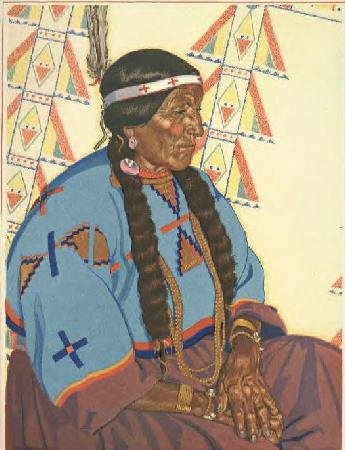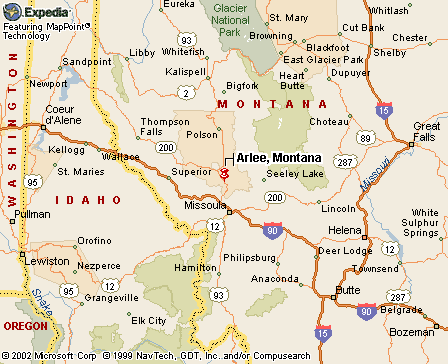|
|
Canku Ota |
|
|
(Many Paths) |
||
|
An Online Newsletter Celebrating Native America |
||
|
September 7, 2002 - Issue 69 |
||
|
|
||
|
Salish Showcase |
||
|
by John Stromnes of the
Missoulian August 31, 2002
|
||
|
|
 ARLEE,
MT - For more than 20 years, Salish cultural leader Johnny Arlee has been
dreaming, planning, writing and rewriting the script for a spectacular
pageant. ARLEE,
MT - For more than 20 years, Salish cultural leader Johnny Arlee has been
dreaming, planning, writing and rewriting the script for a spectacular
pageant.
It would show the world the rich cultural traditions of the Salish Indians before white settlement of western Montana, and depict the historic encounter between the Bitterroot Valley band of Salish and members of the Lewis and Clark expedition almost 200 years ago. It was at this meeting at Ross' Hole in the southern Bitterroot Valley that the Salish, demonstrating remarkable compassion, helped the expedition onward at a critical juncture, instead of wiping out the helpless foreign interlopers, as the Salish warriors easily could have done. For almost 20 years, Arlee, now 61, has sought an opportunity to produce the show. Next week, Johnny Arlee's dream will come to life at the Arlee Celebration Grounds with a unique dramatization of the Salish way of life 200 years ago. It is called Pageant 2002: Salish/Pend Oreille Meet Lewis and Clark. Performances will be Wednesday and Thursday at 10 a.m. (schools are encouraged to attend these morning performances) and Friday and Saturday at 5 p.m. The pageant will include a rich variety of traditional Salish songs, dances and stories. There will be horses, and campfires and tepees and authentic costumes. And stories. Lots of stories, as is the Salish way. Each performance lasts about two hours, and there will be plenty of time afterward "to meet new friends and old friends," Arlee promised. Admission is free. The pageant is produced, directed and performed by some 35 members of the Confederated Salish and Kootenai Tribes - all volunteers - with assistance from the tribal government, which granted "change of duty status" for tribal employees to work on the production during the last several months. The faculty and staff of Salish Kootenai College also helped. Gerald Slater, vice president of SKC, was instrumental in obtaining financing, as was Germaine White of the People's Center, the tribal cultural center in Pablo. Slater knew about Arlee's longtime plans for a pageant depicting important customs and scenes of the Salish people. This year Slater learned about a possible funding source to commemorate the Lewis and Clark expedition, and he thought about Arlee's pageant. Slater called White to help write the grant application, said Jennifer Greene in a story published recently in the tribal Char-Koosta News. Over the next six to eight months, a core group of about 35 people worked to bring the plan to a reality, said Ruth Quequesah, stage manager of the pageant. The pageant unfolds as a grandfather recalls the past and explains it to his grandchildren, taking the audience through a re-enactment that shows important customs of the Salish people, including the Snake Dance, Canvas Dance and Scout Song, among others, Greene said. It concludes with the famous Lewis and Clark encounter. The pageant is financed by a $50,000 grant from the Challenge Cost Share Program of the Lewis and Clark National Historic Trail of the National Park Service. Many thousands of dollars in "in-kind" cost-sharing services will be or have been provided by tribal members and others for the production. The pageant opens with the dramatic entrance on horseback of the acknowledged impresario of the Flathead Reservation, colorful "Colonel" Doug Allard of St. Ignatius himself. Allard, dressed to the nines in buckskin shirt and leggings and feathered warrior's headdress, will set the scene. "This is Johnny Arlee's dream, and so I'm here for John. Whatever John needs, he'll get it," Allard said during a rehearsal Thursday evening, But even Col. Allard could not guarantee the weather. So the pageant, originally planned as an "in-the-round" outdoors experience, has been moved under the big shelter at the Arlee Powwow Grounds for the four performances. Still, there is plenty of room for tepees, and pine trees, and campfires, and horses, and grandstands for the audience. And there were "camp dogs" galore visiting the set in the staging and rehearsal Thursday when a Missoulian reporter and photographer arrived, just in time for the show's Scalp Dancing segment. Arlee, in his persona as Old Charlie, was talking. About 12 tribal people were dancing slowly into the arena. Horses and their riders, some balanced precariously on top of their mounts, had just galloped out. "The people at this camp paint the faces of the ladies, they fix their hair, and they dress them in clothing and headdresses that were worn in battles by the warriors," Old Charlie says. The Scalp Dancers slowly lined up facing one another. The men, some beating hand drums, were on one side, the ladies on the other. There is never any hurry or rock 'n' roll frenzy in the dignified Scalp Dance. In fact, the dance could, in the old days, become a very serious courtship drama. Again, Old Charlie: "This dance was also considered one of the times that the ladies could choose a man to be her husband." The dancers dance, slowly, formally, with measured steps. A scalp, or at least a modern-day representation of a scalp, hangs from a pole carried by one of the costumed women. "During one of these songs you'll see one of the ladies who is carrying a pole with the scalps attached to it. When the dancers arrive in front of the drummers, she would place the pole on one of the drummer's shoulder. If the drummer pushed the pole off his shoulder, it was a sign he was refusing this girl's hand of marriage. But if he left the pole on his shoulder, he was automatically married to this lady. Shouting, war cries and shrills would be heard from the dancers and the spectators" should the pole remain on the chosen one's shoulder, Old Charlie said. Old Charlie also corrects several misconceptions handed down through the white culture. For example, what anthropologist observers called the "Coffee Dance" has nothing to do with coffee. "You see," says Old Charlie, "when this dance was performed a long, long time ago, it was used for the blessing of the first killed buffalo. One young buffalo bull would be selected, killed and brought back to camp. Every part of the buffalo was sacred. When the meat was boiled, the broth of the meat would be placed in the center of camp to be blessed (by the dance). "But later in years, I guess around 1940 or 1950, the Indian people would do this dance as an exhibition, using a pot of boiled coffee instead of the buffalo broth. "I guess that's where the name 'Coffee Dance' came from," Old Charlie says. Of course, in those later days, they had no buffalo broth. Then take the so-called "Snake Dance." "This dance has nothing to do with a snake," says Old Charlie. "When the people who study about the ways of the Indians saw this dance, they called it 'Snake Dance' because this dance was done in a zigzag fashion while dancers entered the encampment. "This dance was performed in memory of some young warriors who were returning home from a raiding party tired and weak. As they entered the camp, they were staggering in a serpentine fashion. ... "This dance in Salish ... means the Dance of the Weaving Back and Forth. The dancers danced in a proud fashion. "We continue to do this dance on the Fourth of July each year, here at Arlee, during our annual celebration." But don't wait for next July's performance to be introduced to the customs and ways of the Salish people of the Flathead Reservation. (Yes, you will learn during the pageant how "Flathead" is another misnomer by the dominant culture, and how such a misunderstanding of a good-faith gesture could occur.) Participants agree that it is very unlikely that the constellation of circumstances and grants and volunteers that brought this pageant to reality for these four days will ever happen again. "This is a glimpse of the Salish world in 1804 - an opportunity to see through the elders' eyes what the people of that time were like - a cultural re-enactment. Johnny's dream has been a cultural restoration," said White of the People's Center. In fact, like all good stories, it is, above all, a moral tale, showing by example how good people behave with other people of good faith in a humane society. It has elements of entertainment, humor and instruction. And it comes mostly from the wisdom Johnny Arlee obtained by his countless talks, recorded on tape, with elders of the tribe while Arlee was director of the Salish Cultural Committee a generation ago. "I talked with Blind Mose and many others. They talked about the old dances, they'd sing the old songs. When I was transcribing the tapes, I laid out the whole thing - and that's how the celebration went," Arlee said.
|
|
|
||
|
|
||
| Canku Ota is a free Newsletter celebrating Native America, its traditions and accomplishments . We do not provide subscriber or visitor names to anyone. Some articles presented in Canku Ota may contain copyright material. We have received appropriate permissions for republishing any articles. Material appearing here is distributed without profit or monetary gain to those who have expressed an interest. This is in accordance with Title 17 U.S.C. section 107. | ||
|
Canku Ota is a copyright © 2000, 2001, 2002 of Vicki Lockard and Paul Barry. |
||
 |
 |
|
|
The "Canku Ota - A Newsletter Celebrating Native America" web site and its design is the |
||
|
Copyright © 1999, 2000, 2001, 2002 of Paul C. Barry. |
||
|
All Rights Reserved. |
||
